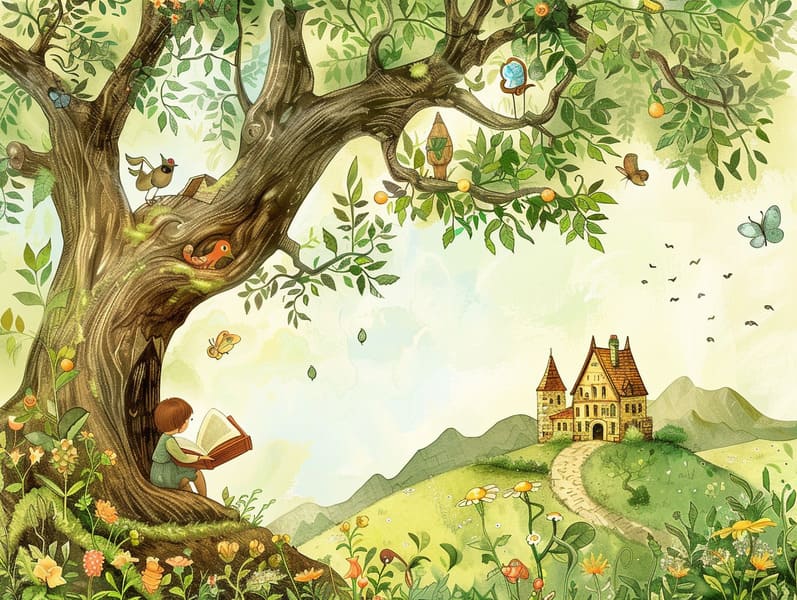Uncovering the Past of Ancient Fairy Tales and Their Invariable Captivation.
Uncovering the Past of Ancient Fairy Tales and Their Invariable Captivation.
Blog Article

Children's fairy tales have ancient roots. These tales have been shared from one generation to the next long before they were ever documented. They originated from a variety of cultures, including African traditions. They were initially told among grown-ups, often carrying themes and messages aligned with the societal norms and beliefs of the time.
The famous Grimm duo, Jacob and Wilhelm, were among the first to collect many of these beloved fairy tales. Their anthology, "Grimm's Folk Tales," included narratives like "Cinderella," "The Bread Crumb Trail," and "Schneewittchen," which have since become mainstays in the world of famous fairy tales. Similarly, Hans Christian Andersen's magical fairy tales, such as "The Mermaid," and "The Duckling's Story," have stolen hearts worldwide, solidifying their place in the pantheon of treasured fairy tales.
Despite their historical roots, traditional fairy tales remain as important as ever, especially as children's bedtime stories. These magical stories are now available in multiple formats, including gorgeously illustrated books, charming animations, and digital fairy tales.
Their lasting presence can be connected to several magical reasons:
Life Lessons: Traditional fairy tales often convey important moral lessons. Narratives like "The Tale of the Boy Who Cried Wolf" teach the virtue of honesty, while "The Race of the Tortoise and the Hare" illustrate the merits of determination and humbleness. These stories offer young readers clear distinctions between virtue and vice, developing their moral compass in a tender yet important way.
Compassion and Knowledge: Traditional fairy tales frequently portray figures facing problems and hurdles, fostering young listeners to resonate with their struggles and root for their triumphs. For instance, "Beauty and Her Beast" illustrates the merit of looking past the exterior to recognize the real character of a individual, promoting empathy and recognition.
Cultural Perception: Many fairy tales are deeply ingrained in the cultural contexts from which they were born. Reading these tales can provide captivating looks into different cultures, nurturing a sense of cultural understanding and recognition.
Fantasy and Innovation: The fantastical elements in traditional fairy tales—talking animals—foster children’s fantasy worlds. These stories lead readers to supernatural realms, fostering imaginative ideas and a sense of mystery that stays a lifetime.
Traditional fairy tales are not only mesmerizing but also didactic. They serve as spellbinding tools in promoting various thinking and feeling skills in children. When timeless fairy tales are narrated, they nurture communication skills by bringing new terms and meanings and complex sentence structures. This practice also strengthens auditory skills and mindfulness, as young readers keep up with the story, prepared to see what happens next.
Furthermore, deliberating the themes and characters of traditional fairy tales can cultivate evaluative skills and logical thinking. The young are shown to recognize patterns, guess what will happen, and figure out cause and effect. These explorations also ease the young communicate their thoughts and feelings, boosting their emotional intelligence.
In today’s modern era, the accessibility of online storybooks has made these stories more acquirable than ever. Online platforms and applications share extensive collections of famous fairy tales that can be looked at or listened on anytime, anywhere. Fairy tales read out loud are particularly prevalent, making available an interactive method for little ones to engage with these fascinating tales. Read-aloud stories and spoken videos move characters and settings to life, often accompanied by whimsical melodies and tunes that improve the narrative adventure.
The timeless fascination of traditional fairy tales lies in their ability to transform this site to contemporary times while continuing with their central messages. Contemporary renditions of these narratives often include more inclusive figures and modern settings, making them accessible to today’s audience. However, the core values of guts, understanding, and lawfulness remain unchanged, continuing to appeal to children of all ages.
Ancient fairy tales also offer a sense of protection and comprehensibility. They serve a tidy narrative with a evident beginning, middle, and end, often finishing with the solving of conflicts and the triumph of justice over injustice. This dependability can be relieving for young ones, offering a sense of steadiness in an constantly changing world.
Classic fairy tales continue to charm and educate new generations, maintaining their delight and applicability in modern society. As children's bedtime stories, they grant a perfect blend of fantasy and learning, promoting moral values, empathy, and creativity. The abundance of online storybooks and the in demand status of fairy tales read out loud promise that these traditional tales remain accessible to new generations.
By holding onto and imparting these stories, we continue to venerate the rich tapestry of tradition and cultural heritage. Whether you are delving into a vividly illustrated book, enjoying a internet library, or listening to an audiobook, the loveliness of Grimm's fairy tales is always within reach. These fairy tales highlight of the timeless power of fairy tales and its ability to connect us across time and space.
Even if you are experiencing a artistically illustrated book, delving into a cyber collection, or listening on an sound book, the mystique of timeless fairy tales is always within reach.
These fairy tales remind us of the persistent strength of storytelling and its ability to connect us across time and space, forming a connection that captivates and teaches alike.